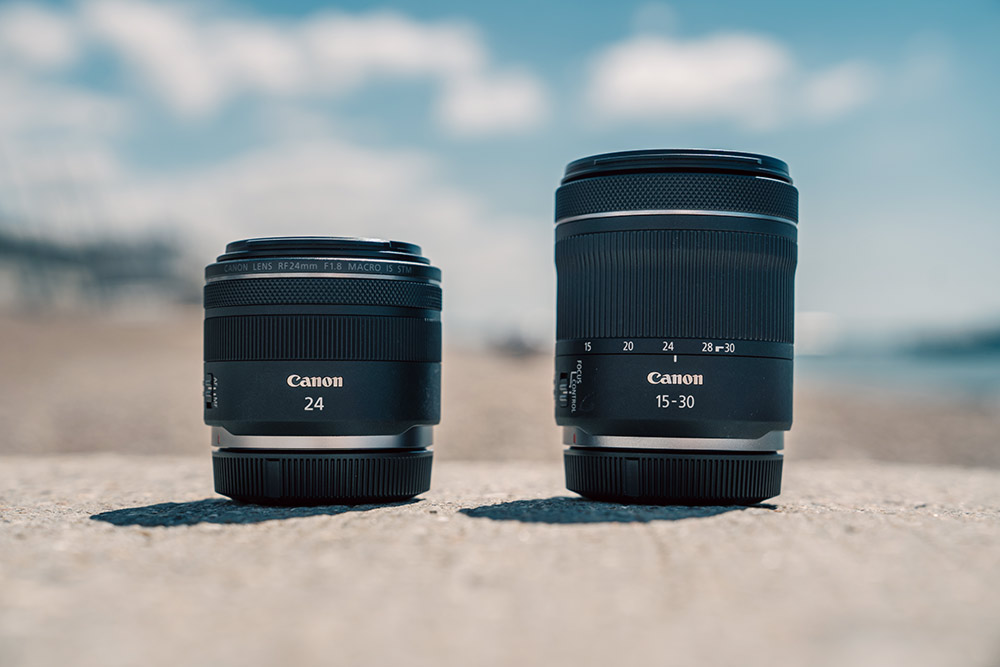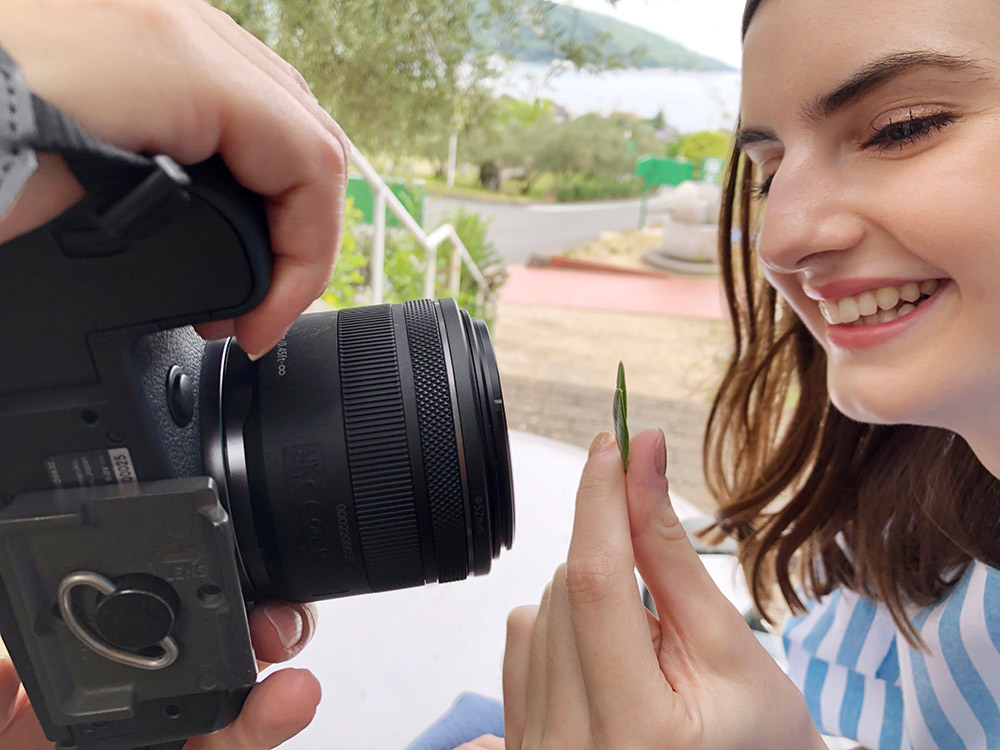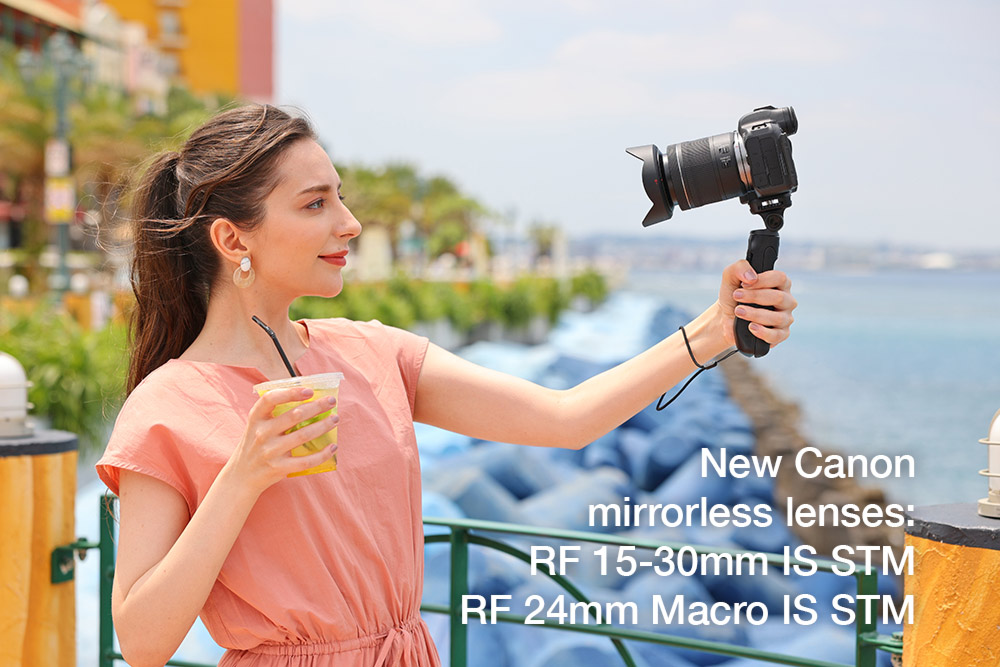- Call us: 01444 237070
- Contact Us
- Stores
- Sign In / Register
-
- Back
- Used Cameras
- Used Accessories
- Used Lenses
- Used Video
- Used Film Equipment
- Used Stock Alert
- Used Blank Test
- Sell or Part Exchange
- Used Clearance
- Recently Added Used Equipment
- Park Picks
- All Used Black Friday Deals
- Faulty
- Trade-In
- Blog
- New in
- Call us
- Contact us
- Stores
- Sign in
- Categories
- Tips & Inspiration
- Reviews
- News
- Events
- Features
- Buying Guides
- Competitions
Canon Adds Affordable Lenses to RF Range
Canon’s RF lens range has expanded with the addition of two affordable non-L lenses, compatible with both full-frame and APS-C mirrorless EOS R cameras. The Canon RF 24mm f/1.8 Macro IS STM and Canon RF 15-30mm f/4.5-6.3 IS STM are extremely compact, portable and include brilliant features to help you create high quality photo and video content, despite their modest price tags.
Our RF lens review covers every thing you need to know about these new lens additions, including sample photos, the release date and how much these lenses cost. You’ll also discover which subjects these lenses are ideal to capture and which features are going to help create your epic content.

How much do the Canon RF 24mm and RF 15-30mm lenses cost?
What makes these latest non-L lenses affordable? The Canon RF 24mm f/1.8 Macro IS STM lens price is £719 and the Canon RF 15-30mm f/4.5-6.3 IS STM lens price is £669. This compares extremely favourable to existing L-Series mirrorless lenses (L for Luxury), which carry a far higher price tag.

RF 15-30mm sample photo holiday vibes at 15mm with Canon EOS R6. Settings: 1/400sec. f/8. ISO 100.
The comparable zoom option in L-series is the RF 15-35mm F/2.8L IS USM, which has an RRP of £2,389.00, whereas the 24mm prime lens doesn’t have a close stablemate, being the only wide angle prime for the range at launch. It does pair well with the two existing non-L options – the ultra-wide angle RF 16mm f/2.8 lens and standard prime RF 50mm f/1.8 lens to pair with the 24mm prime.

100% crop of previous image showing fantastic detail and resolving power combined with the R6 sensor
When were the Canon RF 24mm and RF 15-30mm lenses released?
Both of these lenses were released on the 12th July 2022, following the May 2022 release of the crop format Canon mirrorless APS-C cameras. This is no coincidence as it provides crop format and full-frame shooters with two new options to capture a variety of subjects and extend their lens options affordably. Stock will be available in August (24mm) and September (15-30mm) 2022.

Close focus capabilities of the RF 24mm lens
What features do these RF lenses offer
Despite arriving with appealing price tags, the RF 24mm f/1.8 Macro and RF 15-30mm f/4.5-6.3 share several features with premium options from Canon’s RF mirrorless lens range. These include:
- Built-in optical image stabilisation (IS)
- Combined lens and body stabilisation
- AF stepping motor (STM) technology
- Smooth and quiet focusing for video
- Extremely close minimum focus distance
- High magnification for frame-filling subjects
- Customisable lens control ring
Each feature is designed to help you capture sharper photos and smoother videos in diverse lighting conditions, while minimum focusing and high magnification opens up more creative possibilities with a single lens.

RF 24mm sample photo red rose with Canon EOS R6. Settings: 1/320sec. f/5.6. ISO 200
We highlight specific specifications in the comparison table below, however suffice to say it is possible to achieve absolutely fantastic results with both of these RF lenses, whether you shoot with a full-frame or APS-C format camera.

100% crop of red rose
Canon RF 24mm and RF 15-30mm specs comparison
With both lenses offering wide angle creative possibilities in prime or zoom options, a Canon RF 24mm and RF 15-30mm lens specs comparison table highlights similarities between these models.
|
|
||
|
Lens construction (elements/groups) |
11/9 |
13/11 |
|
Special optics |
1x PMo Aspherical, 1x UD |
1 x PMo Aspherical, 2 x UD |
|
No. of diaphragm blades |
9 |
7 |
|
Minimum aperture |
f/22 |
f/22-32 |
|
Closest focusing distance (m) |
0.14m |
Manual Focus: 0.128m (15mm) Manual Focus: 0.28m (30mm) |
|
Maximum magnification (x) |
0.5x |
Manual Focus: 0.52x (15mm) Manual Focus: 0.16x (30mm) |
|
Control Ring |
Yes |
Yes |
|
Image stabiliser OIS
|
5-stop |
5.5-stop |
|
Combined stabiliser IBIS x IS |
6.5-stop combined IS |
7-stop combined IS |
|
AF Actuator |
STM |
STM |
|
Coatings |
Super Spectra |
Super Spectra |
|
Lens filter diameter (mm) |
52mm |
67mm |
|
Max. diameter x length |
74.4x 63.1mm |
76.6 x 88.4mm |
|
Weight |
270g |
390g |
|
RRP |
£669 |
£619 |
With subtle differences separating these models choosing between them may require some deeper investigation, unless you want a zoom with ultra-wide angle capabilities.
Both will deliver high-quality stills and video footage, refined by special aspherical and ultra low dispersion lens elements. Both lenses feature built-in optical stabilisation, which harnesses body-stabilisation when mounted on bodies such as the EOS R6, R5 and R7.

Sample photo with Canon EOS R6. Settings: 1/320sec. f/2.2. ISO 200
You can capture beautiful close-up photos and movies with either lens, although the 15-30mm zoom relies on manual focus mode in order to achieve it’s highest magnification and closest focusing. When using AF you can shot as close as 0.28m throughout the zoom with 0.09x (15mm) to 0.16x (30mm) magnification.
Other similarities include the STM which is a tried and tested AF system and their compact size and low weight, benefiting anyone looking for handholding, all-day shooting or traveling with their gear.
What subjects can you shoot with the Canon RF 24mm and RF 15-30mm lenses
Both of these models are wide angle lenses, with the zoom offering an ultra-wide 15mm to wide zoom range. The bright aperture in the prime lens sets it apart for handholding in extremely low light situations, as well as for playing with fine shallow depth of field. The kinds of subjects which wide angles are suited to, include:
- Classic landscape and seascape photos where you focus on the grand scene
- Cityscapes and interiors, where you’ll be able to handhold thanks to highly capable IS
- Environmental portraits, reportage and street photography where you want to show the scene
- Video capture and vlogging where the STM is quiet and quick with smooth focus changes
- Close-up macro shots where the frame is filled with your subject

Sample photo with Canon EOS R7 at 18mm. Settings: 1/30sec. f/8. ISO 200
Lens accessories
With both lenses offering a compact filter thread you can add compatible lens filters extremely cost-effectively. This allows you to add a VND variable neutral density filter (VND) for video, circular polariser for landscape photography and a font-element saving clear protector filter, which is ideal for extreme close-ups where the lens can knock your subject. Both lenses come with a hood, dust cap and a pouch, but you might want to add a suitable lens case and lens cloths to wipe away grime.
Video review
Watch our Canon RF 24mm f/1.8 and RF 15-30mm f/4.5-6.3 First Look Review
Which RF lens to choose?
If you are mainly vlogging the RF 15-30mm offers a wider field of view, which is ideal when holding the camera close, and the zoom capability in itself will appeal to many users. The prime 24mm shines when you need the maximum possible aperture to separate your subject and create smooth background blur. It has nine aperture blades over seven, which will defocus more smoothly, providing an edge for portrait, street and macro, particularly in low light.

Ultimately both of these new affordable lenses give us options for capturing diverse subjects including vlogging and filmmaking in low weight, portable packages. You may even decide that having both options in your repertoire is the most versatile solution for your style content creation.
The great news is that Canon mirrorless camera users can now get from 15mm all the way to 400mm, with three affordable and high quality non-L zoom lenses:
- The newest RF 15-30mm f/4.5-6.3 for ultra wide to wide zoom
- The RF 24-105mm f/4-7.1 IS STM for wide to short telephoto zoom
- The RF 100-400mm F/5.6-8 IS USM for super telephoto zoom
The prime could be stowed in your bag for when you want the best low light capabilities, shallow depth of field and to capture extremely close-up images.
Browse and compare Canon mirrorless lenses here to find your perfect line-up and capture the most compelling content to tell your story.
Share this post:
By Nick Dautlich on 12/07/2022
Nick Dautlich
Senior Content Writer and Product Reviewer
Nick Dautlich is the Senior Content Writer and Product Reviewer at Park Cameras, with over 15 years of photography experience. A Sony Imaging Professional and expert reviewer, Nick has worked with major brands such as Canon, Sony and Nikon. His work is also featured on Vanguard World UK’s website, Capture Landscapes, and Shutter Evolve. Nick’s photography includes National Trust projects and magazine covers and he is passionate about landscapes and storytelling. Nick also enjoys hiking and teaching his children about nature. Learn more on his profile page.

Trade in your old equipment
Fast and easy trade in service ensures your old gear is collected efficiently and you are paid quickly! It's very simple to trade in your unwanted photography gear. Just head over to our dedicated Sell or Part Exchange page, fill out the details, and we'll get back to you with an offer for your old gear. Take the cash, or put it towards the cost of your new gear. It's up to you! Find out more
sign up to the newsletter
Keep up to date on the latest photography news, events and offers. Sign up now
